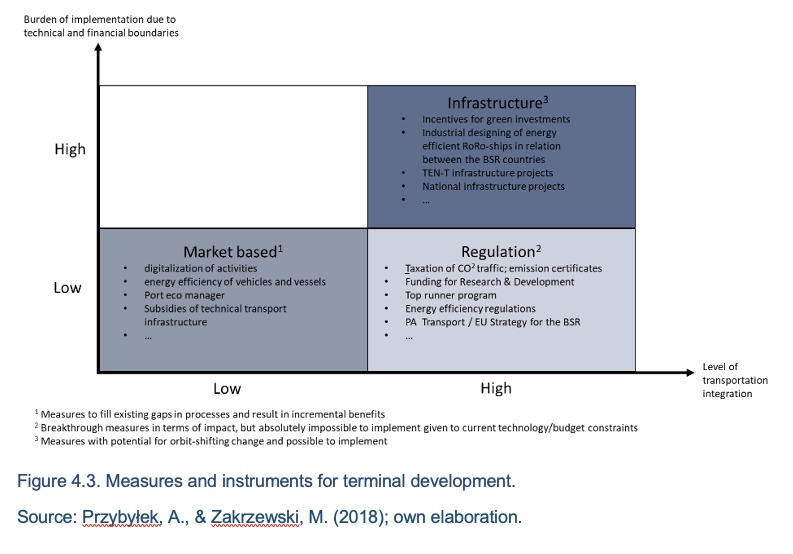4.4.1 Framework conditions and policy options
The EU transport policy sees CT as a major player in the transitioning of the freight transport sector. The most relevant framework conditions for road-rail CT in Europe, but also in the narrower sense of the BSR are defined by UIRR (2021). Table 4.1 summarizes general framework conditions. These conditions are highly relevant for the terminals since these conditions represent the interfaces for freight traffic.
Railway infrastructure
For instance, for the framework conditions of the railway infrastructure, the “European Agreement on Important International Combined Transport Lines and Related Installations” (AGTC Agreement) was signed by more than 20 European states. In this Agreement, minimum standards were set for harmonization of international CT. These standards should be still taken into considered if railway lines are upgraded or even if new lines are built (UIRR 2021, UNECE 2001).
The report on a the “Analysis of the EU-Combined Transport” has noted the comparison of the CT rail services in the EU and United States, where CT rail services makes 67% more traffic than in Europe (KombiConsult et al., 2015). The reasons for this are complex, among other things, the population centers are to be found on the coasts (with the transport distances in between, respectively overland lengths of haul), and rail transport in the United States can also be carried out in double-stack container trains. In order to achieve a significantly higher volume of transport in the CT, the rail infrastructure must be further adapted in order to be able to absorb growing freight rail traffic (e.g., train overtaking at railway stations, operating of separate tracks in passenger and freight rail trains).
Liberalization and regulation
The CT Directive (92/106/EEC) has made a strong restriction to load units of twenty feet units or more and hinder the opportunity to introduce smaller CT units. Smaller units could also expand the scope of CT in urban and metropolitan regions. On the other hand, standardization is one of the main drivers for the development of economics of scale and reduces costs for shipped units (KombiConsult et al. 2015). Therefore, it is recommended to obtain the load units length to create further economic benefit to the CT services. The Directive is limited to distances of road and rail/inland waterway transport (EU-100 km threshold). However, the arguments suggest that these distances do not match (e.g., channel crossing ferries, extended road transportation). More flexibility would be helpful, i.e., a measure to limit the road leg in relation to non-road leg (KombiConsult et al, 2015; EC, 2001), and the limiting of the road leg in CT rail/road ratio operation. The main arguments in conclusion are to call for adjustments of the CT Directive, or moreover to develop a new CT Directive.
In addition, there is the recommendation to strengthen the CT support programs (e.g., grants for terminal investments, cross-border infrastructure investments in core routes), and to gather CT statistics. Overall, important aspects of measures to change EU-wide combined transport are discussed by KombiConsult et al. (2015) and should continue to be active in order to change the transport relations, also with regard to the further development towards a common European single-market.
Moreover, for the framework conditions of liberalization, the European Commission deals further with the opening up of transportation (mainly with ongoing integration of the first, second, and third railway package). The EU drew up new framework conditions from the early 90s by means of various Community legislative instruments (Directive 91/440; Directive 92/106/EEC). The Directives clearly distinguishes between infrastructure and operation. The main objective of the Directives (and Regulations) starting in 1990s is to harmonize the European rail market (UIRR, 2021; UIRR, 2000). The study by KombiConsult et al. (2015) suggests to re-evaluating the CT Directive to determine whether, among other things: (1) the measures are still relevant (relevance), (2) the measures have been met (effectiveness), (3) whether the relationship between costs and Benefit equals efficient, and (4) whether the level of EU policy is coherent.
External (costs)
An externality arises when a person engages in an activity that influences the well-being of a third party who neither pays nor receives any compensation for the (positive or negative) effect. The social costs include the external plus the private costs of production. The social costs are always higher than the private costs. These social costs must be internalized in the production process (internalization of external costs) in order to achieve an efficient outcome (Jahn et al. 2020). Frémont and Franc (2010) showed that the transportation sector is the only major sector of the economy in the EU that is responsible for a growing percentage of CO2 in total emissions of the EU. Nevertheless, the per unit emissions have decreased significantly over the last decades, for reasons of cleaner engine technologies or economies of scale. However, the action for policy is enormously and the acceptance of combined transport is highly relevant from the external costs relations to other transport modes as trucks to haul freight.
Costs (internal)
Costs, for example, that incur regardless of the length of transportation are:
- infrastructure costs,
- transshipment costs, and
- administration costs.
Reduced terminal costs are relevant for the competition between the modes and are able to re-distribute or rather to reshape the competition of the modes. Modern terminals are subject to high fixed costs, the investment costs are immense. The utilization of the terminals is optimally at a maximum of 80%, after which further infrastructural adjustments are necessary due to avoiding congestion costs. The terminal infrastructure always includes or is defined by the superstructure and the digital infrastructure, which is becoming increasingly important. They are all relevant to be addressed by policy instruments.
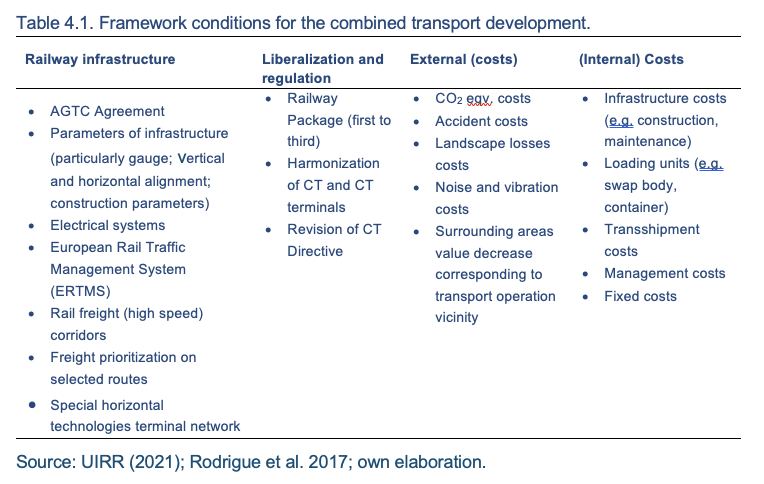
Political measures—such as regulatory instruments, market-based instruments, as well as infrastructure and market liberalization instruments—can be introduced in the interface of the above mentioned four capabilities to reduce emissions and have a positive impact on the transport sector (Table 4.2). The further adjustment screw is in which modal split changes are to be brought about in order to achieve a corresponding control towards more combined traffic and terminal efficiency.
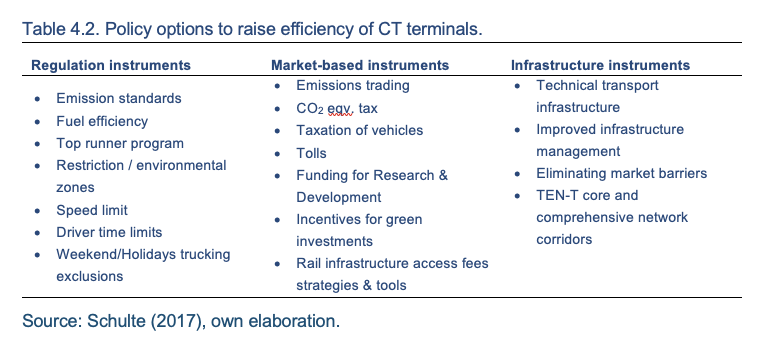
4.4.2 Scope of action for the EU and BSR
The CT in Europe shows that the BSR includes many countries with a high rail share in the link between Central and Eastern European countries such as Western Europe. The most traffic goes to Germany. However, some selected characteristics for the BSR CT market is: (1) various number of sea ports with growing volumes; (2) different track gauges (standard gauge 1,435 mm in Poland, Germany, Denmark, and Sweden, and 1,520 mm gauges in Estonia, Latvia, Lithuania, and Finland) and track/train compatibility; (3) semi-interoperability for the modal shift of semi-trailers electrification; and (4) and rail share in total freight volume and intermodal share in rail freight is very heterogenous distributed between the Baltic Sea and EU countries. The conclusion is that especially the Central and Eastern European countries have a great potential to increase the shares of intermodal transport. The fact of this increasing intermodal transport results in more investments needs for terminals (Bielenia et al., 2020; Bochynek et al., 2020; Wiśnicki, 2020).
The scope of action for the development of terminals in the BSR relies on the above outlined major capabilities. Most challenging are measures and instruments to address the function of connectivity, interface, and buffer to increase the capacities and reliability (e.g., throughput congestions and service frequency) on the one hand, and with regards to energy and environment on the other (e.g., emissions reduction and other external effects reduction). Common challenges that have been identified are congestions and infrastructure, organizational and process optimization, such as energy and sustainability (Rodrigue et al. 2017).
Figure 4.1. summarizes the different levels of interaction for seaport and inland terminal, which are guided by the most important capabilities and function.
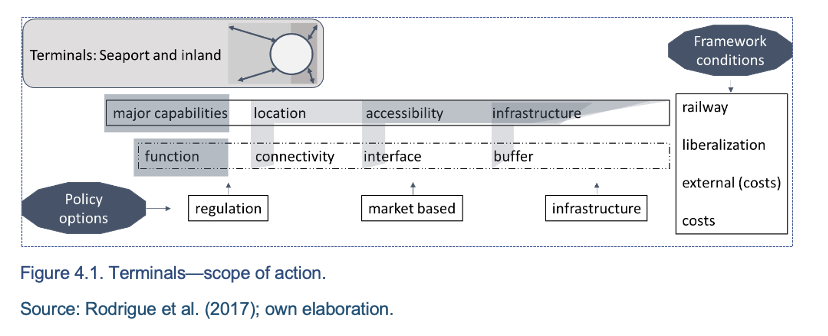
Congestions and infrastructure
The terminal position is relative, the situation can change over time regarding the technology, growth opportunities, and trade relations. The quality and efficiency of terminal connections define their competition potential (Biermann et al. 2015; Rodrigue et al. 2017). Although terminal serve as destinations there are de-facto nodes for composition (first mile) and decomposition (last mile). Terminal, moreover, are linked to the concept of centrality, the “origin” or the “end” of the traffic volume, or to the concept of intermediacy, the intermediate node in freight transportation.
Studies preparing for infrastructure investment should include a demand forecast of intermodal transport services. The transport node in which the terminal will be located should be specified, i.e., whether it is an international, national, or local node. It is necessary to determine the economic potential of the terminal service area, i.e., the number of ITU that can be generated by industry and habitants in the close and distant area of terminal road haul service. As a distant service area, Wiśnicki (2020) recommend a freight truck travel time of up to 90 minutes to/from the terminal should be assumed as the maximum value. However, other authors recommend on medium and short distances up to 100 to 300 km goods, road transport is at this distance faster and presents more flexibility than any other mode of transport (Carboni et al., 2018; Jahn et al. 2018; UIC, 2020).
A new terminal location should be of multi-criteria choice, of which the most important criteria is the access to transport infrastructure and the economic potential of the terminal service area. In the first group of criteria, locations with access to transport infrastructure of international significance within TEN-T corridors. Trimodal terminals should be considered with access to the waterway network. In the second group of criteria, large areas for investment are consumed, i.e., large rail-road terminals are determined by a minimum area of at least 50 ha.
Organizational and process optimization
From the point of view of the terminal operator, the key factor is the development of horizontally linked global corporations (i.e., market reach) and vertically integrated corporations (i.e., control of transport chains). Current developments indicate a slowdown in global economic integration, but still the integration into global value chains will continue to grow.
Internal costs are costs that a business bases its price on. The faster these terminals operate and the lower the operational costs are, the higher the competitiveness of the combined transfer (Hanssen et al. 2012, Ishfaq and Sox 2012; Jahn et al. 2020). The effectiveness of terminals determines the (operational) costs. The business-management selection of handling equipment should be realized on a multi-stage investment process. The handling capacity of the terminal should be increased together with the increased handling and storage needs. The most common in market practice is a gradual terminal transition from stage of primary handling by reach stackers, through introducing gantry cranes (RTG or RMG), up to the stage of implementing a wide spectrum of handling and transport services on several transshipment fronts. The latter stage is related to the terminal cooperation with one large or several smaller logistics centers guaranteeing sufficient cargo volume, i.e., at a level above 0,1 million ITU.
In addition to investments in the infrastructure, bottlenecks can also be countered with further operational optimization measures (UIC et al., 2007, FIS 2021):
- Use of interim storage areas, loading tracks and handling equipment, for example through price reductions in off-peak times;
- Improvement of the punctuality in the main run to reduce buffers, respectively to raise capacities;
- Efficient control and automation of processes; and
- Implementation and adaptation of innovative information and communication systems to push, diversify and prioritize terminal services.
A large number of national and European directives and standards are relevant for the legal background of combined transport. Main EU-directives are 92/106/EEC, 96/53/ECC, and 2015/719/EU (amending of 96/53/EEC (EC 1992, EC 1996, EC 2015, SGKV 2021.) The directives help particularly to standardize cross-border traffic, also in the BSR. Consistent implementation helps to integrate planning reliability and legal certainty.
Energy and sustainability
Besides financial costs which we are referring to as internal costs, challenges also emerge from the impact of transportation activities on the environment (Jahn et al. 2020). Transportation is always in conflict with social and environment conditions. Transport in general has an impact on climate change and is impacted by climate change. Transportation amounts for an enormous percentage share of CO2 emissions (around 24% worldwide) (Jahn et al. 2020; Rodrigue et al. 2017 Frémont and Franc 2010; Froese et al. 2019). Terminal can be regarded as a major player in the transition of the transportation sector. Intermodal transport may have additional social benefits other than emission saving. It may reduce other forms of external costs from road freight such as land use, accidents, congestion, or noise. CT is less costly in external costs (Jahn et al. 2020).
Moreover, new terminals should be managed and adapted to the automation of terminal processes, starting with appointment system and inspections at terminal gate up to selected transshipment operations. Conventional terminal will transform into a fully automatic combined terminal, but technology is important for terminals that should offer their clients complex energy monitoring and carbon footprint tracking, i.e., monitoring of CO2 emissions.
Figure 4.2. summarizes the main challenges that affect the seaport and inland terminals. It becomes clear that the interfaces of the measures and instruments should influence the policy options (1) regulation, (2) market based, and (3) infrastructure.
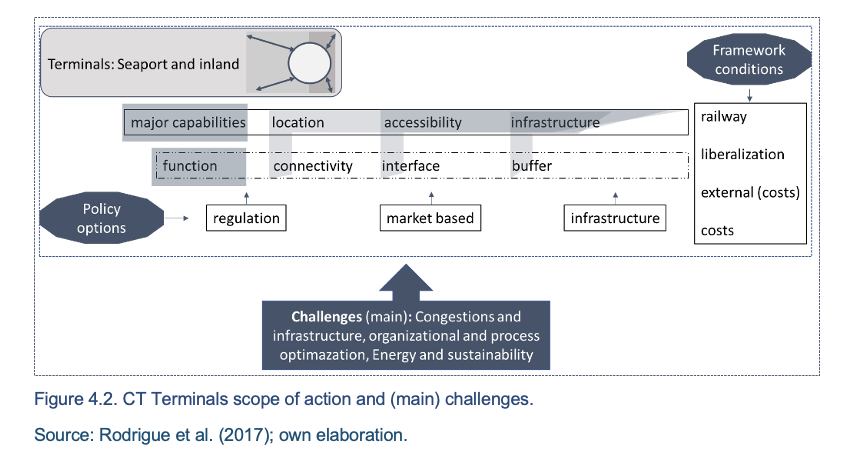
Measures for action in a time dimension model
Summarizing the results, “positive” terminal projects can be simply classified along two dimensions: the “level of transportation integration” and the “burden of implementation due to technical and financial boundaries”. These two dimensions form a 2×2 matrix that results in the following four groups of a “How-Now-Wow”-model (Przybyłek and Zakrzewski 2018).
- Measures with a low “level of transportation integration” combined with a low “burden of implementation due to technical and financial boundaries” are labelled as “Marked based” that fill existing gaps and result in incremental benefits. They consist of process optimization (e.g., through digitization), increased measurement of environmental indicators, management problems, and enhanced efficiency. These are measures that fill existing gaps in processes and result in incremental benefits.
- Second, measures with a low “level of transportation integration” combined with a high “burden of implementation due to technical and financial boundaries” are labelled as “Regulation”. Breakthrough measures in terms of impact, but absolutely impossible to implement given to current technology/budget constraints are sorted here.
- Third, measures with a high “level of transportation integration” potential but also a high “burden of implementation due to technical and financial boundaries” are entitled as “Infrastructure” and contain breakthrough measures that are somehow impossible to implement with the current state of technology and budget. Similar to the previous two groups, the focus lies on process optimization. An example, but visionary, is the idea of a tube system (“hyper-loop”) which could transport containers within ports or to transportation nodes in the hinterland (e.g., freight yards or dry ports). On the other hand, on the non-vessel side, all other vehicles such as cranes or trucks shall switch from fossil fuels to electric engines.
- Finally, measures with a low “level of transportation integration” a high “burden of implementation due to technical and financial boundaries” are of small interest since they do not generate additional value for new concepts. Therefore, the measures are not considered further here.
In Figure 4.3, the results are combined with the above findings and the levels of the measures are summarized. It also becomes clear that the labeling addresses a certain temporal dimension and thus a ranking of the measures themselves. Results for the BSR are highlighted within the matrices.
